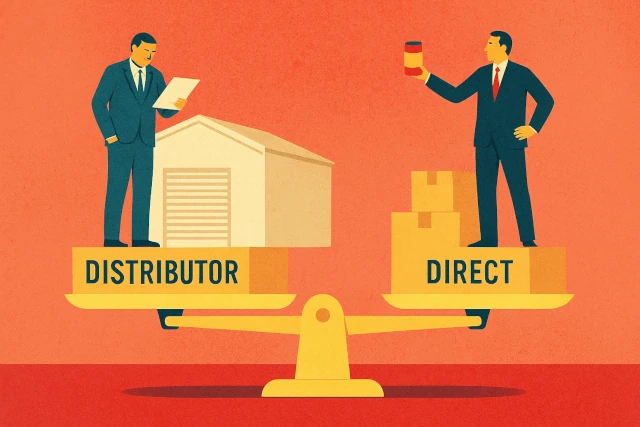Should I Go With a Distributor or Sell Direct? And What’s the Real Break-Even Point Where It Makes Sense to Switch?

If you’ve got early traction with your food brand and are gaining retail interest, the question inevitably comes up: Should I keep selling direct, or should I sign with a distributor like UNFI or KeHE?
Most advice on this topic is frustratingly binary—either “go with a distributor ASAP” or “never touch a distributor until you hit scale.” The truth is more nuanced. The right decision depends on your margins, cost of goods, your team’s capacity, and your ability to drive sell-through. Let's walk through the analysis I use with brands when they hit this critical fork in the road.
Why This Isn’t a “One-Size-Fits-All” Decision
There are three main paths for getting into retail shelves:
- Selling direct to store (DSD) – You invoice stores yourself and often deliver the product too.
- Selling through a distributor – Like UNFI, KeHE, or a regional option like Associated Grocers or Horizon.
- Hybrid – Start direct, then flip regions or chains over to distribution as volume grows.
Each model has its trade-offs. The key is to model the economic break-even point and the operational trade-offs, so you can transition smoothly rather than out of panic.
Direct vs Distributor: What Are You Really Trading?
| Factor | Direct | Distributor |
|---|---|---|
| Gross Margin | High (40–60%) | Reduced (20–35% to you after distributor & retailer cut) |
| Reach & Access | Limited to relationships & reps | Instant access to thousands of retail locations |
| Logistics | DIY: warehouse, shipping, delivery, returns | Handled by distributor (but you pay for it in margin) |
| Control of Execution | High (you own the buyer relationship) | Low (you rely on distributor reps) |
| Sales Team Requirement | Large (you manage accounts & support) | Smaller (but you still need to drive demand!) |
| Invoicing & Collections | Manual, time-consuming | Simplified—one invoice from distributor |
Understanding the Real Costs of Each Path
Before we talk strategy, let’s compare the actual economic models side-by-side. Here’s a simplified breakdown for a $6.00 MSRP product in grocery:
Scenario A: Selling Direct to Store
- MSRP: $6.00
- Retailer margin (typically 35%): -$2.10
- Your revenue per unit: $3.90
- COGS: $1.50
- Freight: $0.30
- Labor/admin (invoicing, packing, AR): $0.40
- Net contribution: $1.70/unit
Scenario B: Selling Through UNFI or KeHE
- MSRP: $6.00
- Retailer margin (35%): -$2.10
- Distributor margin (20%–25%): -$1.17 (based on a 25% margin)
- Your revenue per unit: $2.73
- COGS: $1.50
- Freight allowance / distributor fees: $0.20–$0.30
- Admin (EDI, chargebacks, spoils): $0.25
- Net contribution: ~$0.68/unit
Difference: You’re giving up ~$1.02 per unit in contribution margin by using a distributor.
But does that mean distributors are always bad? Not quite. Now let’s consider what you’re gaining—and what your true break-even point is.
What Are You Really Getting from a Distributor?
Distributors aren't just logistics providers—they’re the gatekeepers to many retail accounts. Here's what they offer (and don’t):
What You Gain
- Access to hundreds or thousands of retail doors
- Centralized warehousing and consolidation (especially helpful for chain accounts)
- Reduced need for small-scale fulfillment and drop shipping
- Legitimacy with larger buyers who expect to order from their preferred distributor
What You Don’t Gain
- No guarantee of pull-through—they ship, not sell
- You’re still responsible for promotional funding (MDFs, scan-backs, etc.)
- You need a broker or field team to sell to retailers, even after onboarding with UNFI or KeHE
- Chargebacks, spoilage, and deductions can eat into margins unpredictably
Bottom line: a distributor gets you in the store, not off the shelf.
Factor In Staffing and Operational Complexity
If you’re selling direct, here’s what you (or someone on your team) is doing:
- Manually entering and managing invoices
- Packing and shipping small orders (often case-by-case)
- Chasing payments (AR can balloon with independents)
- Managing inventory storage and small-batch production cycles
Once you pass ~75 to 100 active accounts, direct becomes operationally painful. If you don’t have at least one full-time ops person, you risk losing money through admin errors and burnout.
That’s where distributors shine—they consolidate orders, normalize terms, and reduce your internal admin load. But only if the volume supports it.
Calculating the Break-Even Point
Here's how to estimate the true break-even for using a distributor vs staying direct:
Step 1: Calculate Marginal Profit
- Direct: ~$1.70/unit
- Distributor: ~$0.68/unit
Step 2: Determine Cost of Internal Labor
- Let’s say your ops/admin labor costs $50,000/year total
- If you’re selling 30,000 units/year direct, your labor cost per unit is $1.67/unit (!)
Suddenly that $0.68 margin via distribution doesn’t look so bad compared to a $1.67 burden on internal ops.
Step 3: Include Promotional Spend
Distributors require promotional funding, and big retailers often demand scan-backs, free fills, and ads. Assume an average of 15–20% of gross revenue goes back into promotions.
Step 4: Build a Crossover Table
| Units Sold Annually | Profit via Direct | Profit via Distributor |
|---|---|---|
| 10,000 | $17,000 | $6,800 |
| 25,000 | $42,500 | $17,000 |
| 50,000 | $85,000 | $34,000 |
| 100,000 | $170,000 | $68,000 |
But again—are you staffing up or outsourcing ops? The moment your direct channel needs another employee, your costs jump and the distributor starts looking more appealing.
When Should You Use a Distributor like UNFI or KeHE?
If you’re pursuing accounts like Whole Foods, Sprouts, or Fresh Thyme, you won’t have a choice—those retailers expect to pull from UNFI or KeHE.
That’s not necessarily a bad thing. These distributors are solid for national or regional retail chains. But here are my rules:
✅ Use a Distributor When:
- You’re in 50+ stores across a region
- You're targeting chain retailers who require distributor fulfillment
- You have a broker or internal sales support to drive sell-through
- Your margins can tolerate 25–35% erosion
- Your ops team is overwhelmed handling DSD (direct store delivery)
🚫 Avoid Too Early If:
- Your velocities are unproven
- You don’t yet have consistent promotional funding
- You rely on selling story or education that needs a hand-sell
- You lack visibility into reorder rates and inventory turns
The biggest myth is that UNFI or KeHE “sell” your product. They don’t. They distribute what you sell to buyers. Don’t make the mistake of thinking your product will move just because it’s in their system.
My Hybrid Approach (and What I Recommend)
The smartest brands I work with don’t pick sides. They build hybrid models:
- Sell direct to independents and specialty stores—build brand and margin
- Use distributors only when a retailer requires it or when your DSD costs exceed $1/unit
- Keep clean records of turns, reorder rates, and velocity to evaluate distributor success
- Negotiate terms—push back on free fill quantity, negotiate down spoilage fees
Distributors aren’t evil. They’re a tool. But like any tool, use it only when the job requires it—and make sure your margin math supports it.
Final Takeaways
There’s no universal right answer to the distributor vs direct question—but there is a right answer for your business model. Take the time to run the numbers. Compare your labor burden. Understand the real costs of indirect selling. And know this:
- Distributors solve logistical problems, not marketing ones
- If you can drive your own sell-through, you’ll be fine with either model
- Don’t chase prestige retailers if your margins aren’t ready for distributor cuts
Stay focused. Track everything. And run your business—not just your products—like a true operator.
Need a template for break-even analysis? Chat with me and I’ll send you the model I use for COGS vs. margin planning.













